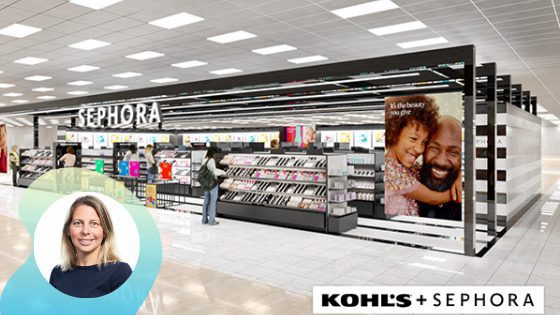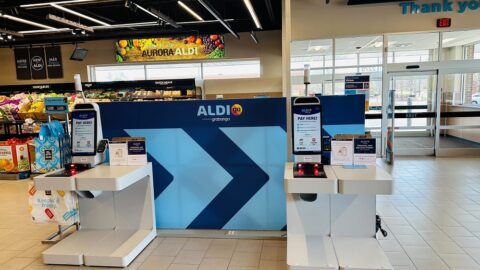As the world reopens in full force amid COVID-19 vaccination efforts, brands seek new ways to turn customers’ in-store experience into something that not only makes them feel safe but keeps them coming back and staying longer.
The growing trend of “Russian nesting doll” stores is when larger stores host small outposts for well-known brands. The nested doll, or outpost, brings excitement and new shoppers to a physical shopping experience that needs new energy. Retailers like Kohl’s, Target or Hy-Vee host small retail outposts for brands such as Sephora, Apple or DSW, respectively.
The strategy intrigues customers and draws new footfall for both brands. Many upscale department store retailers like Selfridges, Galeries Lafayette and Neiman Marcus have employed a heavy “concession” model for years, and others like Best Buy and Tesco experimented too, but like omnichannel customer expectations, COVID-19 accelerated the shop-in-a-shop trend across all types of mainstream retail. However, the idea of one shop nested in another can bring complexity for store organizations. As retailers look to hop on this bandwagon, we have some recommendations and advice to meet the challenges of the store-within-a-store model.
Turning Knowledge into Power
For many retailers, it seems the primary goal of the store-within-a-store model is to rejuvenate customer interest in physical shopping. It can also double as a convenient way for broadly-focused brands to experiment with homing in on a product area of interest, such as Nordstrom’s recent activewear push coinciding with their agreement with the at-home fitness company Tonal. In essence, these moves represent a strong push among brands to pivot to a customer-first mindset in their retail planning.
Advertisement
However, it may not be easy for retailers to leverage the bifurcated sales data they acquire during the trial periods, let alone put that information to good use. How can a brand know which traffic is attributed to internal marketing efforts vs. driven by their embedded stores?
Facing the complex task of data analysis, artificial intelligence can help retailers determine customer promotions of interest and potential customer churn. Many retailers see the value in upgrading to solutions that offer a single, 360-degree view of the customer, allowing them to track how peoples’ spending habits change in response to new accommodations — such as the embedding of nested stores. New cloud capabilities enable a retailer to better predict customer demand and respond with individualized recommendations for shoppers, in real time, with superior demand forecasting. With help from new and constantly improving analytical tools, brands can turn their data challenges into competitive advantages.
Winning the Space Race
Though the benefits of nested stores are compelling, making them a reality comes at the cost of one of brick-and-mortar retail’s most precious commodities: space. Granted, many retailers have surplus space due to over-expansion, but how you use the space you have is paramount. What store-in-a-store will be the right complement to your assortment to drive maximum sales? In addition, retailers have had to become more creative and innovative with their store footprint to accommodate social distancing amid the global pandemic. The nested store becomes an experiment in demand generation.
One way to prove the physical store can still drive retail business is by exploring the nascent world of AI-powered assortment planning. Affinity analysis suggests that specific product arrangements inspire customers to purchase more products or increase their cart sizes. Brands should use these techniques to inform and explore their options to maximize the nested store model’s promise.
Eliminating the Empty Shelf
Space isn’t solely a prized commodity on the sales floor, either. Nearly any store-within-a-store model will mandate a store-wide shift in inventory management to make way for new products and increased storage from the partner brand. And inventory management has become more important as customers have lost patience with missing products: Recent Oracle research shows more than 63% of global consumers turn to an alternate store or retailer when their preferred item is out of stock.
New inventory management offerings can help retailers deal with the added complexity of nested store inventory using end-to-end monitoring tools. Often powered by the cloud for faster implementation, inventory management software can designate items as concession SKUs and track real-time inventory, while not taking ownership of the items themselves. They can also automate many of the tedious tracking processes that burden store associates today. Alternatively, some retailers have employed a “Skunk Works” strategy, wherein at the beginning, they leverage a separate inventory or POS system within the business for a specific project like a pop-up or nested shop. This helps brands isolate their inventory and sales results for the project to understand better where resources must be devoted and overcome logistical complexities.
Once a complete, fully automated view of organizational inventory is achieved, brands can employ built-in predictive models to optimize their supply chain, preserve margins and adapt more quickly to any new challenges from the store-within-a-store model.
Let’s Get Physical
Though the pandemic has been brutal on brick-and-mortar sales, retailers are wise to bet that consumers still crave the unique feeling of browsing shelves at a physical store. An Oracle survey recently found that as many as one-in-four consumers miss the tangible aspects of shopping, such as trying on clothes and sampling products, and will likely return to stores once social distancing is a thing of the past. The record-breaking sales and long queues outside Primark stores and in the first week of reopening supports the idea of pent-up demand post COVID-19, but longer term, only retailers who can offer new ways of delighting their customers will keep them coming back for more.
In other words, the retail industry is likely headed for a period of change, but there remain plenty of opportunities for stores to thrive. As the in-store experience continues to evolve to meet customer demands — like with the latest in Russian doll retailers — brands should consider implementing technology solutions that can help them stay ready for whatever comes next.
Lara Livgard has over 20 years of experience working in retail, with a primary focus on merchandising business processes and software implementation for enterprise transformation projects. In her current role leading the Merchandising, Analytics & Enterprise Solution Management team, she is responsible for the strategy, messaging, and overall product management of these solution suites. Lara has an extensive consulting background and has worked with leading retailers all over the world in every major vertical including fashion, department store, electronics, pharmacy, DIY, grocery and hypermarket. Read more from Lara on the Oracle Retail blog.









